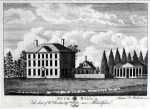
Fever 1793 By Laurie Halse Anderson
Fever 1793 by Laurie Halse Anderson is about how the epidemic yellow fever affected the life of a young girl, Mattie Cook. It takes you on a day by day journey of a young girl struggling to survive in a world that is dying and almost non-existent. Mattie’s story starts off in Philadelphia, Pennsylvania in 1793 during the dry and hot summer. Mattie helps her mother run the family coffee shop. The first occurrence of any illness is when the servant girl Polly mysteriously dies.
As weeks go on the epidemic has killed hundreds, Mattie’s mother becomes ill and diagnosed with yellow fever. A doctor comes to diagnose her mother and tells her that Dr. Rush, who is a prominent physician has been using the methods of purging and bleeding. So Dr. Kerr decides to drain Mattie’s mother and after that Mattie has to give her mom a bath every four hours. When the fever tends to get worse Mattie i travels into the country with her grandfather where Mattie becomes ill and is taken to Bush Hill hospital. After her recovery she traveled back the coffeehouse where her grandfather gets killed by two robbers. The book then goes on to describe Mattie’s journey where she founds Eliza her old cook who was living with her brother Joseph. Joseph had two little boys and Mattie found a little girl named Nell. Mattie lived with them and soon helped other who were in need. When all of the children inhabited the yellow fever she took care of them at her coffee house. One morning a frost spread over Philadelphia, so everyone took their furniture outside to clean it of the fever. Mattie’s mom, who had traveled to the country had come back. The bigger sign of hope was that George Washington had returned home. In the end of the story Mattie had matured into a responsible adult; she got the coffeehouse up and running and she learned that life really does have a purpose and that every day should be valued.
Fever 1793 is a children fiction novel but even though it is fiction it is still is very educational. The hospital that Mattie went to when she inhabited the fever was called Bush Hill hospital. Bush Hill was actually the most prominent hospital used during the epidemic. Bush Hill was set up on Andrew Hamilton’s estate on Bush Hill and it was organized by a French physician, Dr. Deveze. http://www.philadelphiahistory.org/akm/lessons/yellowFever

http://www.ushistory.org/carpentershall/history/fever.htm
The doctor that was mentioned was Dr. Rush. Dr. Benjamin Rush was the most common physician that stayed in Philadelphia during the epidemic. He used a method called purging and bleeding. He encouraged his patients to purge and then would extract large amounts of blood from them in hope of cleansing them from the virus. Dr. Rush became ill twice during the epidemic and he used his own techniques which worked for him. http://www.philadelphiahistory.org/akm/lessons/yellowFever
The epidemic was believed to be brought in by slaves coming from the Caribbean. Then it was transferred and spread by mosquitoes, it helped because that summer was especially hot and dry which was perfect weather for the insects. The coffeehouse still had customers in the beginning of the epidemic because it started by the docks and the water. The coffeehouse was six blocks away so it took a while for the disease to spread. When Dr. Kerr explained that Dr. Rush used the treatments of purging and bleeding it was said that Dr. Rush had not used those methods yet so Dr. Kerr couldn’t have referenced that information. Also the treatments of bathing the fever victim weren’t as popular as soaking the patients feet and letting them drink tea. When Mattie became ill it was September 12 which is the same date that the hospital was made a place for the victims to go and get treated. After Mattie recovered she went back to her coffeehouse and two robbers killed her grandfather. The city was said to be very dangerous when actually it was the opposite. Philadelphia was a place of helping volunteers. The major didn’t leave and he and volunteers offered help to people such as; helping bury the dead, transporting ill people to Bush Hill and giving money or bread to those in need. During the time banks, newspapers and the post office were still open. And watchmen volunteered at night. There were people like Eliza, the cook, who were African American and acted as nurses going from house to house helping those in need. The African Americans that immigrated were said to be immune to the fever and therefore more helpful to those who weren’t; however, they weren’t immune but they did still act as nurse. In the book it mentioned George Washington coming back home as a sign of hope; Governor Mifflin returned as did commercial businesses which really sparked hope to the people of Philadelphia. http://www.geocities.com/bobarnebeck/children.html
Works Cited
Anderson, Laurie Halse. Fever 1793 New York: Simon & Schuster Books for Young Readers, 2000.
Arnebeck, Bob. A Historian’s view of Anderson’s Fever 1793. <http://www.geocities.com/bobarnebeck/children.html>
Karsch, G Carl. The Yellow Fever Connection. Carpenter’s Hall. Copyright 1999-2009. Independent Hall Association. <http://www.ushistory.org/carpentershall/history/fever.htm>
Powell, J.H. Bring Out Your Dead: The Great Plague of Yellow Fever in Philadelphia in 1793. Philadelphia: University of Pennsylvania Press, 1993<http://www.philadelphiahistory.org/akm/lessons/yellowFever>